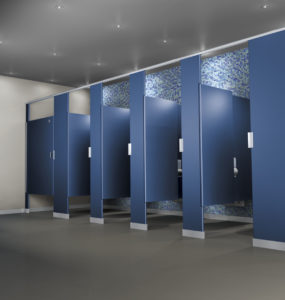Have you noticed that the expenses of the restrooms in your facility are leading to high costs? Whether it’s excessive maintenance and repairs or unnecessary waste, those dollars and cents can add up to an overwhelming total. Fortunately, there are plenty of ways you can cut back on costs and save money by changing some things in your commercial facility’s restrooms.
We’re going to help you cut the costs with some of the top ways to save with your commercial restroom!
Reduce Your Energy Consumption
You may not realize it, but your lightbulbs are costing you a fortune! You can easily combat this by swapping them out with LED lights, which not only last longer than incandescent bulbs, but they also use way less energy to light up the restroom. You can reduce the costs even further by installing motion sensors, which will turn out the lights when there’s a lengthy period of inactivity in your restroom.
Utilize Motion-Sensing Faucets and Hand Dryers
Sometimes, the unnecessary expenditure of water can show a spike in your water bill. Whether an occupant leaves the water running or there’s a drip occurring throughout the day, it can end up adding to your overall costs. Installing motion-sensing faucets can greatly reduce water waste. Occupants won’t forget to turn off the faucet or fail to tighten the valve enough, reducing the water that gets wasted throughout the day.
Another way you can save with occupants washing their hands is by getting hand dryers. This prevents you from having to reorder paper towels each month. Not only will you notice a drop in expenditures on toiletries, but you’ll be taking your restroom into a greener direction.
Install Cost-Efficient Toilet Partitions
You may not realize it yet, but your toilet partitions can be a big red flag when it comes to the high costs of maintaining your restroom. Traditional partitions with a paper core are left susceptible to the elements, namely humidity and moisture, which can sprout mold within the partition and call for an entire replacement. Since mold is nearly impossible to remove from the interior of a partition, the entire partition needs to be replaced, which leads to high costs.
You can forgo replacing your partitions by choosing a material that can stand up to the moisture and humidity. HDPE (high-density polyethylene) plastic is one of the best materials for commercial restrooms due to its solid construction, non-absorbent exterior, and the fact that they’re built to last and are warranted for 25 years. These partitions are also low-maintenance, which saves you money over time by spending less man hours and money in the restroom. These partitions pay for themselves in just a few years due to the money you saved on maintenance.
Learning More About Saving Costs with Your Restroom
In this guide, you learned that when it comes to cutting costs in your facility’s restroom, you’ll need to utilize the right materials to truly see the money you’ve saved. Want to learn more about HDPE and how it can benefit your restroom? Check out this blog post, How HDPE Partitions Can Save You Money, from your friends at Scranton Products!
Take your HDPE research even further by seeing how it would look in your facility with our 3D Partition Visualizer!





